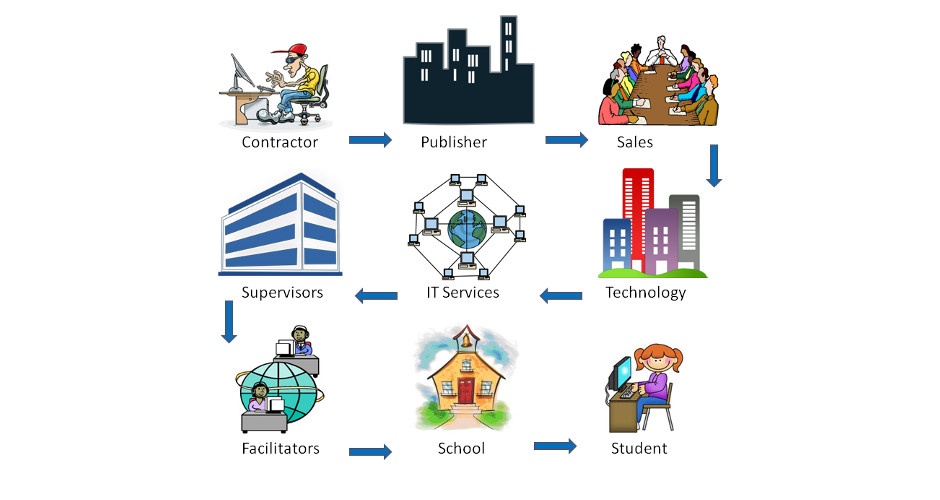In 1978, Pfeffer and Salancik published External Control of Organizations. The full title is “External Control of Organizations – a resource dependence perspective“. The authors make the point that those who control the resources control the organization. If an organization is dependent on outside resources then whoever controls those outside resources can control the organization.
Today most resources pass through a supply chain. That’s a series of steps between the raw materials and the consumer. We usually think of a supply chain in terms of manufacturing. Raw materials are needed to produce a consumer product. A factory manufactures the product. Transportation delivers the product to the store. The store employs someone to sell the product. This is the supply chain.
Any point along the supply chain presents an opportunity for control of a resource. The longer the supply chain the more opportunities for control. Let’s consider how this works with our food supply.
During the Great Depression, many survived because they had a backyard garden and chicken coop. Farms were close by and many communities were food self-sufficient. The supply chain was short.

What does today’s supply chain look like?
Today, we have many more choices when it comes to food. But that comes with a long and complex supply chain. In many cases, the food is not grown in the community or even in the United States.
Consider the steps along the way where resources can be controlled. Where are these located? More importantly, who is controlled?

Quite a bit has been written about resource dependency and supply chains but the information and the discussions have not reached the popular media. Drees and Heugens, writing in Journal of Management report on over one hundred-fifty studies that support the theory of resource dependence. In his blog, Risky Thinking, Robbin Gaddum, extends the idea of supply chains and dependency from manufacturing to services.
After reading what these researchers and bloggers had to say, I found it easy to take the example of how supply chains work with our food supply and apply it to education. Applying resource dependence theory to education suggests that people and institutions can be controlled through manipulation of the supply chain.
 In the fall of 2016, I attended an ESSA public forum and was struck by how much more elongated the supply chain had become. When I began teaching in 1970, the supply chain resembled the food supply chain of the 1930’s. Teachers had textbooks but there were no ancillary materials such as workbooks, prepared lesson plans, or resource banks. There certainly were no prepared tests of any kind – no summative, no formative, and no interim assessments as these were the responsibility of the teacher.
In the fall of 2016, I attended an ESSA public forum and was struck by how much more elongated the supply chain had become. When I began teaching in 1970, the supply chain resembled the food supply chain of the 1930’s. Teachers had textbooks but there were no ancillary materials such as workbooks, prepared lesson plans, or resource banks. There certainly were no prepared tests of any kind – no summative, no formative, and no interim assessments as these were the responsibility of the teacher.
Contrast that to what we are seeing today. During that ESSA forum I attended, there was no mention at all about relying on teacher assessments and professional judgment. Rather it was about collecting data for some higher level to analyze and then make recommendations. In fact, the supply chain described was phenomenally complex. Assessment information (AKA student data) would be uploaded to the state and analyzed. After the analysis, improvement suggestions would be sent back to the school.
While some might have been thinking “hooray!” as the teacher did not have to design assessments, I was struck by the fact that this system created absolute dependency on a supply chain. In addition, it would take weeks to learn something that I could have figured out by the end of the class period.
Robbin Gaddum made five points in his blog on Supply Chain Continuity Insights. However, it is the first that resonates with me. That is you pay for interruptions – NOT the supplier. It’s those interruptions that make us dependent and leave others in control.
http://web.unitn.it/files/download/12425/the_external_control_of_organizations_ch3_pfeffer.pdf
Pfeffer and Salancik. External Control of Organizations. 1978.
http://journals.sagepub.com/doi/abs/10.1177/0149206312471391
Synthesizing and Extending Resource Dependence Theory – A Meta-Analysis
Jonannes M. Drees and Pursey P.M.A.R. Heugens.
http://risky-thinking.blogspot.com/2011/08/supply-chain-continuity-insights.html
Robin Gaddum.


